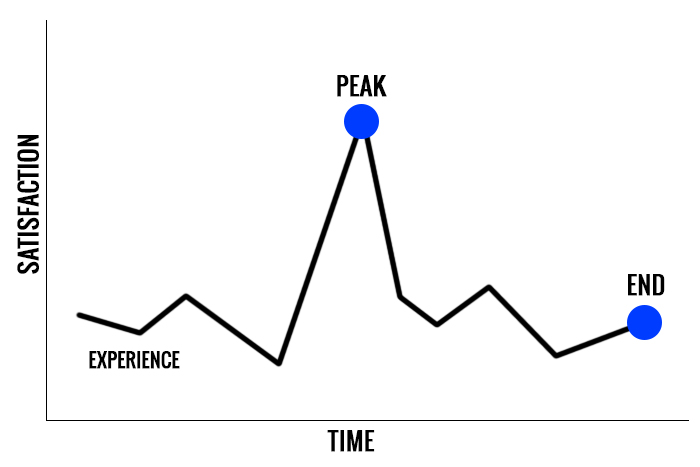When was the last time you traveled? Take a moment to re-visit that trip. I’m sure the first thing you’ll remember were the great moments you had. That one epic adventure or that one night out or that one story you love to tell. You’ll probably remember how that trip ended as well, but maybe not so much everything in between.
Why is that? A psychological heuristic known as the Peak-End Rule may actually explain this phenomena. The basic premise of the Peak-End Rule is that people judge their experiences primarily by how they felt at its peak (the most intense moment, good or bad) and its end, rather than the complete experience in totality. A key point for the heuristic is that there must be a definite starting and ending, although the duration matters less. Everything outside of those two key points are still there, but we simply overlook them when we recall our experiences. They aren’t part of the equation when we judge whether something was good or bad, fun or boring. All that matters are those two key moments.
Everything outside of those two key points are still there, but we simply overlook them when we recall our experiences. They aren’t part of the equation when we judge whether something was good or bad, fun or boring. All that matters are those two key moments.
For example, you could have a generally terrible time on a trip, but there’s that one day that was amazing, and the end turned out alright. How will you remember it? You probably won’t recall the endless days of boredom, but rather that one brilliant moment you experienced.
It’s pretty crazy when you think about. Hours or days can be boiled down to these two key moments. Why these two moments? There are different reasons.
The peak is memorable primarily because they often coincide with moments of intense emotion. While the cause is unclear, it has been shown that those moments of high emotion are more memorable than others.
The end is memorable because of another phenomenon known as the recency bias. Essentially this means that you best remember the thing that happened most recently. Put the two together and you get the Peak-End Rule. So what does this mean?
For one, your judgement on whether something was good or bad may be distorted. You may love a movie because of a single brilliant scene. You may rate a restaurant five stars because they gave you a free dessert at the end. The scenarios where this rule can have an impact are endless.
It also presents a unique opportunity for businesses to improve their customer experiences. What you need to do is address these two questions.
1. How can I create intense experiences that are positive?
In most cases there will likely be a climax, a moment where the intensity will peak – will that moment be a positive one for people or a negative one?
If there is no obvious climax, then do your best to manufacture one. Find a way to delight your customers: make things easier, solve unexpected problems, and anticipate customer needs.
We already see this everyday. Maybe you’re headed to a restaurant in downtown, but have no clue where you’re going to park, only to find the place offers complimentary valet. How convenient!
What if you’re waiting in line to get the latest iPhone, but don’t want to spend your day twiddling your thumbs. Don’t worry, we’ll text you when your number is up (if only). No need to waste your entire day.
Small interactions that make life easier, can go a long way in turning an uneventful or even poor experience into a positive one.
And it goes both ways. If you don’t see how to create positive experiences, at least minimize the negative ones. You don’t want a single terrible moment to ruin the entire experience.
2. How can I make sure the ending is memorable?
The other part of the equation is of course to ensure that the ending moment is positive. How can you go above and beyond for your customers, so that despite what may have happened during the duration, they will end that experience satisfied.
What if when you’re dining out you provided customers with a to go box with extra sides and a complimentary dessert? What if at the end of a tough sale, you threw in something small to make the deal a bit better.
These may seem like little things, but they can make a big difference. As Shakespeare said, “All’s well that ends well.”
Life is about creating and living experiences that are worth sharing.Steve Jobs
The Peak-End Rule is an interesting heuristic that can be a powerful tool for businesses. Crafting your customer experience can make a major impact on success or failure.
At the minimum, you should try to get the potential peak and end perfected, as that will clearly go a long way in making any experience a positive one.
